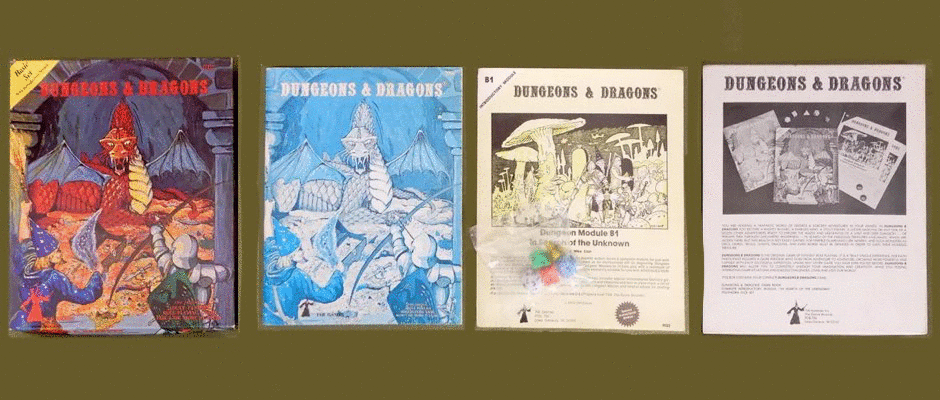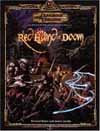This review is way overdue since this book was released around the same time as WOTC’s disappointing Races of the Dragon. Procrastination and more interesting things to write about definitely put my Gaming section on the backburner, that and it has been the biggest magnet of spam for my site. However, this adventure is probably the best book WOTC has published for 2006 and I must recommend it to my friends who play D&D or other fantasy RPGs (I think my friends Neal & Deb still stick with RoleMaster).
Red Hand of Doom is an epic adventure but not in the same style as recent mega-modules Return to the Temple of Elemental Evil or the recently concluded Age of Worms in Dungeon (a worthy investment of $40/year to any DM who is strapped for free time). Those adventures are really mini-campaigns that start with low-level characters and by the module’s completion, the PCs are high-level badasses. These publications are more like games within the game or worse, tabletop versions of Baldur’s Gate or Diablo. I don’t care for them. I’m one of those DMs who believes the heroes should progress into high-level characters over time, not straightforward monster killing. Red Hand is much better since it has more in common with Malhavoc’s event book series: When the Sky Falls or Requiem for a God. For those of you not familiar with an event book, they’re for when your players’ characters have reached a decent level (usually 6th or higher), have developed a reputation amongst allies and enemies, and then it’s time for the campaign world to spring an event on them such as a war, a plague, etc. It’s an opportunity for the heroes to make a difference in the world by being more active participants in defending the kingdom. The only downsides of Malhavoc’s event books are the supplemental materials introducing more junk the game doesn’t need (prestige classes, spells, etc.) and the adventure side is more of an outline, not fully developed, traditional D&D module. Here Red Hand excels because there are several dungeon-crawl elements to keep the PCs at the center of the action a la The Lord of the Rings movies.
I won’t spoil the entire plot but it’s rather obvious, a goblinoid horde is making its way over the land and the human kingdom in their way is unprepared. For decades, the kingdom never really worried about the goblinoids because rivers and mountains served as adequate barriers. Plus the goblinoids were factionalized and fought amongst each other so the threat they posed was downplayed. Recently, someone (or something) has been unifying the various tribes under one banner, the Red Hand, for the last few years. When the PCs are drawn into the adventure, they stumble upon a goblin scouting expedition which means an invasion is coming. But c’mon, they’re an assorted bunch of goblins, hobgoblins and bugbears, PCs of 6th level or higher can stomp them easily. Until the PCs discover the Red Hand’s allies and just how many goblinoids the invasion force contains. Even an Epic-level group of PCs can’t repel an army on an open battlefield.
Everything you need to run this adenture is included in the appendix. Since it uses elements from supplemental books such as Complete Divine,Draconomicon, etc; WOTC incorporates all the relevant details so you don’t have to purchase them. If they didn’t, DMs would have to spend another $200 or rewrite numerous NPCs. Who says they’re always out take everyone’s last dime? There’s a timeline showing the DM how the invasion is scheduled if the Red Hand isn’t hindered and how many days to push back the battleplan when the PCs succeed. There’s that appendix I mentioned earlier giving out all the relevant stats of the unique enemies, unique allies and the mundane, standard forces, all in the new format established since the release of DMG II. My favorite part is the goblins’ strategy guide against the PCs as the adventure unfolds day by day. Strategy? There will be numerous fights between standard goblinoids versus the PCs. Even with the 3.5 rules, a band of 5th-12th level heroes could defeat a company of goblinoids reinforced with goblinoid clerics and wizards in their sleep. Where’s the challenge? Those goblinoid encounters are equal to killing rats in for miniscule experience pointts in Baldur’s Gate. Not so in Red Hand. As the invasion timeline progresses, the goblinoids know who the PCs are so they resort to more cooperate tactics, then dogpiling the PCs via the rather confusing grappling rules (but I’ve been practicing). Eventually, only strong leaders can get the troops to make any attempts on the heroes since the mundane goblinoids know the futility of it. Basically, there will be NO one-on-one fights between the heroes’ best warrior(s) and some typical hobgoblin soldier throughout the adventure.
The Bottom Line: It was already obvious I liked this product from the beginning of the review and with a cover price of $25, it’s definitely a bargain. With all the work put into it, the amount of time it can save a DM makes it worth almost twice as much. Integrating this into the published campaigns is relatively easy (that’s elaborated in the beginning). Integrating it into your own homebrew campaign is only as difficult of how developed it is. If you’re just starting, buy this and piece it together in the background so when the invasion begins, it won’t feel contrived. My campaign is rather spotty thus I have much more homework to do since the Himrak tribe of Orcs from The Silver Summoning have been more of backdrop problem. Final thought too. When I was writing this review, I realized why I enjoyed this adventure immensely. It’s not only part event book and part mega-module. It’s really the 3.5 heir to the well-loved Bloodstone series of modules that introduced the Forgotten Realmscampaign world to 1st edition D&D.
From Austin to Adelaide
8915 Miles!Seattle
weeks0-5days0-2hours0-7minutes-3-8seconds0-8Categories
Friends of Picayune
Meta

